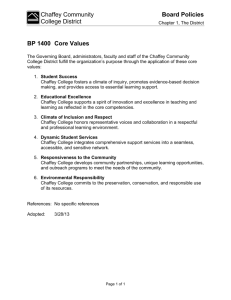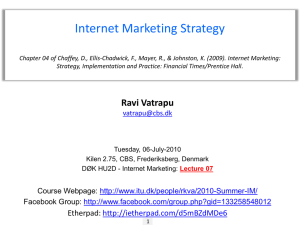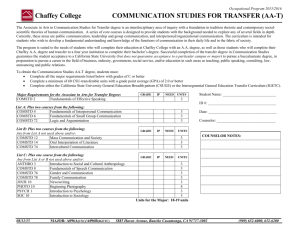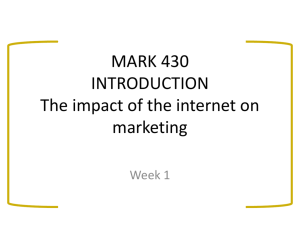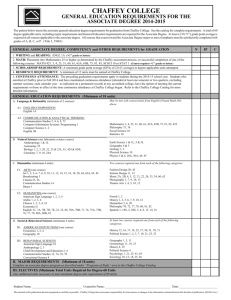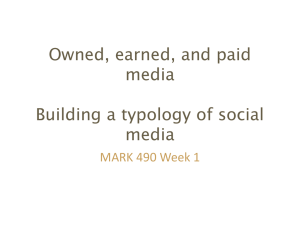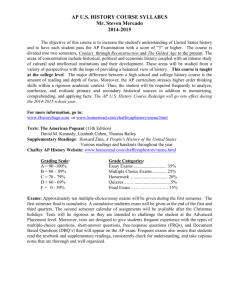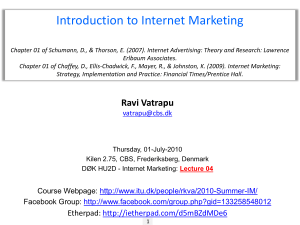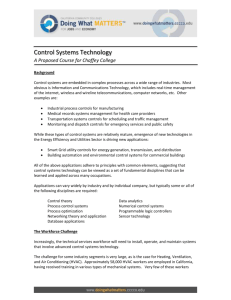Introduction to internet marketing
advertisement
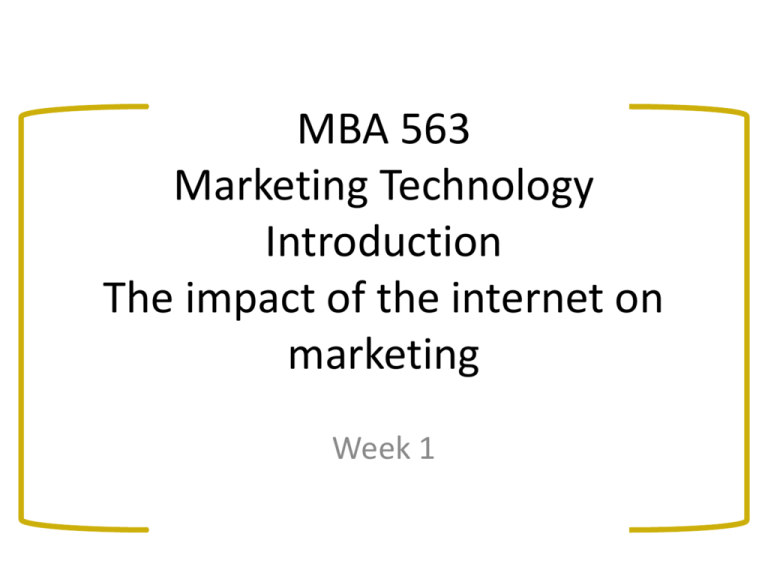
MBA 563 Marketing Technology Introduction The impact of the internet on marketing Week 1 What is internet marketing? • Online marketing/ eMarketing / digital marketing / web marketing / internet marketing? • The application of the internet and related digital technologies in conjunction with traditional communications to achieve marketing objectives ……Dave Chaffey http://www.smartinsights.com/digital-marketing-strategy/online-marketing-mix/definitions-of-emarketing-vs-internet-vs-digital-marketing/ Why study internet marketing? • Over the past 20 years traditional marketing practices have been transformed – October 27, 1994 – first banner ad – Digital marketing continues to grow and attract marketing dollars – The influence of Web 2.0 in the late 90s and early 2000s, product digitization, and now the impact of mobile computing – Continuing strong growth in business-to-consumer and business-tobusiness eCommerce • New skills, knowledge and strategies in high demand in the business world – very strong demand in this area • Marketers need to understand technology and collaborate with IT colleagues TECHNOLOGIES USED IN MARKETING Some technologies used in marketing • • • • • • • • • • • • • • Web (HTML 5 / CSS 3) Instant messaging SMS (Text messaging) “over-the-top” messaging via data (eg. Viber, WhatsApp) Voice and Video over IP (VOIP) eMail P2P file exchange / streaming technologies Location-awareness / location based services (LBS) Mobile Apps (native to mobile operating systems) Augmented Reality (AR) Near-field communication (NFC) iBeacon and Bluetooth Low Energy Virtual reality (VR) Voice and image recognition Consumer Devices • Mobile – – – – Cell phones and smart phones eReaders Tablets Wearables (glasses, watches, rings, bands, tattoos etc) • Desktop – Personal computers (desktop and laptop) – Gaming consoles – VR/AR headsets and motion detectors • Internet of Things (IoT) THE ONLINE MARKETING TOOLBOX The online marketing toolbox. Owned, earned or paid? Blogging Video Mobile Interactive display advertising Twitter General social networks The internet marketing toolbox Niche social networks Search engine optimization Search advertising eMail AR, VR The importance of distinguishing between owned, earned, and paid media • When selecting tools for a marketing activity we have to look for three distinct aspects of those tools • Different purpose and return on investment for each “Owned” media • Owned media: “media owned by the brand. Online this includes a company’s own websites, blogs, mobile apps or their social presence on Facebook, LinkedIn or Twitter [etc]” Dave Chaffey One of Dell’s twitter accounts Starbucks on Pinterest “Earned” media • Earned media: “Earned media also includes word-of-mouth that can be stimulated through viral and social media marketing and includes conversations in social networks, blogs and other communities.” Dave Chaffey Comments posted to the Skyrim Reddit pages (not owned by Bethesda) Liking, sharing, and commenting on a Starbucks’ Facebook post Instagram sponsored post “Paid” media • Paid media: “media where there is investment to pay for visitors, reach or conversions” Dave Chaffey Twitter promoted account Google Adwords PPC advertising Owned, earned & paid media – the overlaps http://www.smartinsights.com/digital-marketing-strategy/customeracquisition-strategy/new-media-options/ Owned, earned and paid media: role, benefits & challenges http://www.smartinsights.com/digital-marketing-strategy/customer-acquisitionstrategy/new-media-options/ The bigger picture of internet marketing Planning and management Email / messaging Domains, usernames, hashtags Being found Demographics Market research Advertising Own Website Social media (owned & earned) Content & technologies Text, video, images, AR, VR Analytics, Data management Law, Regulation, ethics THE 4PS IN TRANSITION The impact of the Internet on the traditional marketing mix framework • Product – new products, the rise of the “prosumer” • Price – dynamic pricing, comparison pricing, bidding……..FREE! • Place – direct distribution of digital products, supply chain management, channel integration • Promotion – new social and communications media, measurable advertising • Strong trend towards personalization and away from the mass (undifferentiated) market affecting all the elements of this framework • The Six “I”s Framework – – – – – – Interactivity Intelligence (market) Individualization Integration Industry restructuring Independence of location MacDonald and Wilson. The New Marketing, 2002 Source: eMarketing eXcellence. 2012. Smith &Chaffey Interactivity • The internet is not TV • Conversation, not broadcast • Pull, not push • Active rather than passive (lean-forward medium) • Social Networking / User Generated Content Source: eMarketing eXcellence. 2012. Smith &Chaffey [Market] Intelligence • By the very act of using the internet, we are “telling” marketers what we want: • Passively • Clickstream data • Web analytics • Actively • Social network updates, photos, videos, reviews, forum postings etc Source: eMarketing eXcellence. 2012. Smith &Chaffey Individualization Same message to all customers or segments Traditional media Message tailored to each customer or micro-segment New media • The market of one: based on the information about customers that we provide, and that is collected automatically and monitored constantly • Amazon for example Source: eMarketing eXcellence. 2012. Smith &Chaffey Integration • Online marketing is very readily integrated into a marketing communications strategy • Web channels complement and integrate with offline marketing channels – EXAMPLES? • Call a customer service rep for assistance • Movie trailers on YouTube Source: eMarketing eXcellence. 2012. Smith &Chaffey Industry restructuring and Independence of location INDUSTRY RESTRUCTURING • Disintermediation – traditional intermediaries used by marketers disappearing • Re-intermediation new intermediaries (eg. PayPal) • Business models challenged LOCATION INDEPENDENCE • Increased reach to global markets • Increased exposure • Increased competition Source: eMarketing eXcellence. 2012. Smith &Chaffey Product trends online • Digital value – adding value to products through online means • Digitization – product or place? • Personalization – individualized products and the “prosumer” Source: eMarketing eXcellence. 2012. Smith &Chaffey Digital goods distribution • Any product that can be digitized can be delivered over the Internet • Online distribution costs are significantly lower – No inventory problems – No product depletion • Completely new business models based on digital distribution methods • Internet becomes a direct substitute for an offline distribution channel eg. online banking Source: eMarketing eXcellence. 2012. Smith &Chaffey Some industries that are undergoing rapid change due to Internet forces affecting product and place • • • • • • Recorded Music industry Video/DVD rental industry Newspaper and magazine publishing Banking Book publishing Textbook publishing • Forces for change: – Digitizable product – Self service – Direct to consumer shift – Personalization Pricing • Internet influences – buyer and seller perspectives of price • Moving from free to fee (and freemium) • Price comparisons / transparency • Dynamic pricing Source: eMarketing eXcellence. 2012. Smith &Chaffey Online promotion • We will look at the many new techniques available to marketers to promote goods and services online • The big value of internet marketing – ability to measure results and therefore performance based Source: eMarketing eXcellence. 2012. Smith &Chaffey
